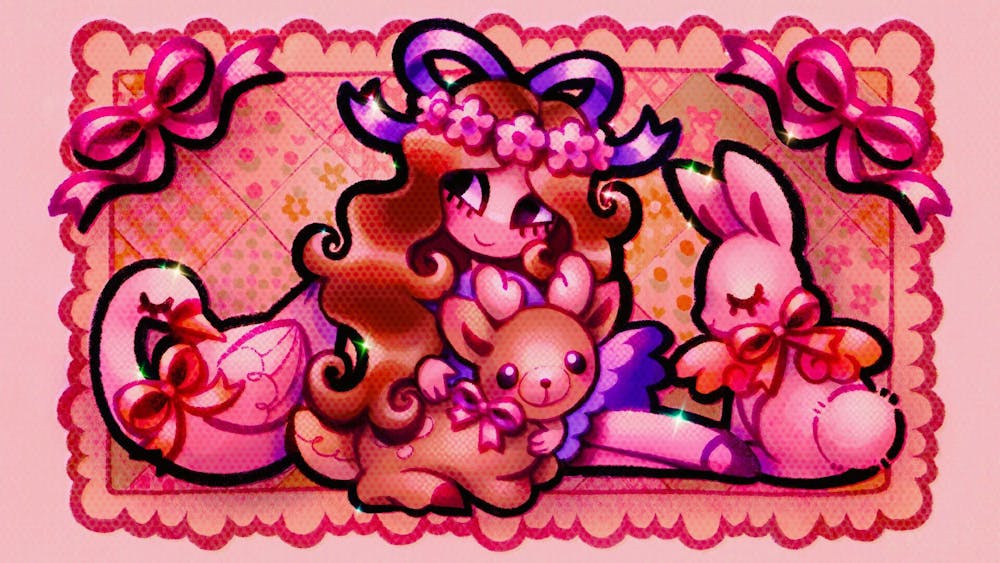Like many other young women, I was raised with a seemingly unexplainable vendetta against the color pink. Since blue became my favourite color over pink at the ripe age of four, I’ve actively avoided anything to do with it—in my clothes, my room decor, my tech accessories. Pink has always been too girly.
But all things feminine are having a huge resurgence: coquette–core is currently storming Gen Z fashion circles. According to Nylon, “searches for 'coquette' started to rise dramatically in November 2021, increasing by three times compared to the month prior.”
In general, coquette fashion is associated with hyper–femininity and nostalgia. That means wearing frills, lace, and satin, putting ribbons in your hair, and rocking Mary Janes. The style is classy, emulating ballet– and cottage–core, but it is still playful. If you’ve walked into Urban Outfitters lately and seen their new Kimchi Blue collection, that is coquette fashion. Big fashion houses have also picked up on the coquette trend: Miu Miu debuted their viral satin ballet flats during Paris Fashion Week 2022. Dior’s 2023 ready–to–wear runway collection from Paris Fashion Week 2023 also has elements of coquette fashion. Although most of the looks do not look entirely coquette, many of them contain coquette elements, such as ribbons and lace. Smaller fashion brands like Selkie, LoveShackFancy, For Love & Lemons have also embraced the coquette look.
The coquette aesthetic has been around for a while though. “Charming girly bedrooms (floral bedding, pink walls, antique furniture, record players), Lana Del Rey GIFs and romantic poetry were synonymous with coquette fashion on Tumblr blogs in the 2010s,” according to LA–based stylist Marisa Ledford. Lana has long embraced the style and her Born to Die and Paradise tours in the early 2010s fueled the trend. Besides the artist, coquette fashion also draws inspiration from movies and shows like Bridgerton with its light colour palette and Regency–era fashion or Sofia Coppola’s 2006 film Marie Antoinette with its ornate costumes.
The trend has also made its way onto the red carpet. Lily Rose Depp mixes coquette fashion with the effortless French girl aesthetic. One example is her look for the premiere of her movie Wolf in 2021: she donned a lace purple dress with a matching ribbon in her hair.
As beautiful and nostalgic as this fashion style is, it is not without its controversy. The word ‘coquette’ is defined as ‘the woman who flirts,’ giving the impression that someone who dresses in coquette fashion is trying to get male attention. Critics of coquette fashion have pointed out the aesthetic’s promotion of a girlish look, from a male gaze, and its tendency to infantilize women since many coquette pieces could easily be seen as children’s clothes. There are also problematic subsets or subcultures often associated with coquette, like the ‘Lolita’ and ‘nymphet’ aesthetics. ‘Lolita’ is a reference to the eponymous 1955 novel by Vladimir Nabokov, about a 12–year–old girl (Lolita) who is preyed on by her 37–year–old stepfather.
Dressing ‘Lolita,’ in the American context, is often associated with the sexualisation of girlhood and innocence. Lana Del Rey, the ‘it’ girl of coquette fashion, has also been accused of glamorising abusive relationships and the toxic dieting lifestyle of the 2000s. In general, critics have pointed out the trend historically being led by thin, white women, leaving a lack of diversity in the fashion style.
The increasing popularity of coquette reveals the power of TikTok creators in influencing, and promoting, fashion trends. Other styles that coquette core take after include ballet core, the old-money aesthetic, cottage core, soft–girl core, all of which have been prevalent on TikTok.
While there is nothing inherently wrong with any of these fashion styles, they have been criticised for their ability to romanticize domesticity and the patriarchy. Cottage core romanticizes house work like baking bread and hanging the washing out from a beautiful house in the countryside while dressed in the perfect white frilly dress. The old–money aesthetic romanticizes traditional family values where women take on their maternal roles while dressing glamorously in Ralph Lauren. The soft–girl aesthetic romanticizes the soft sensitive sides of femininity that subtly emulate a damsel in distress. Obviously these are generalizations—to dress one way does not mean to live out the lifestyle. However, given TikTok’s ability to influence how we think and behave, fashion cores could produce romantic and ultimately unrealistic expectations of how women should act and perceive themselves.
Despite these critiques, the newest resurgence of coquette fashion distances itself from ‘Lolita’ fashion by focusing on hyperfemininity rather than the sexualization of innocence. For coquette core influencer Nia, or @dollclubxo on TikTok, it goes beyond how she dresses: from how she decorates her room, to how she speaks. Dressing coquette does not have to define how someone lives their life, but for those who see the aesthetic as an extension of their personalities, coquette can be a celebration of the girlhood that women have been encouraged to shun in order to grow up and succeed in life. Coquette core is changing that by turning back the clock with nostalgia and letting people heal their inner child.

